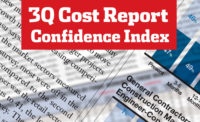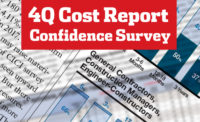Q4 Cost Report: Execs Believe the Market Still Isn't Running on Empty

The construction market is cyclical, and industry leaders know this. It has grown during the past eight years, but there has been an underlying question of when the construction boom would end. Now, there is a growing sense that the market has one more good year of expansion, but that the end is near.
This mood of resignation can be seen in the latest results of the ENR Construction Industry Confidence Index survey. The CICI dropped to 59 in the fourth quarter, a decline of 11 points from the third-quarter survey. Of the 250 executives from large construction and design firms responding to the survey, most believe the market will begin to decline in late 2019 or early 2020.
This sense of an impending downturn doesn’t mean that the current market is softening. For example, only 7% of survey respondents believe the market is beginning to fall now, and only 8% say it will be in decline in three to six months. On the other hand, 31% believe the market will start shrinking in a 12-to-18-month timeframe, compared to only 18% who believe it will still be in a growth mode.
The CICI measures executive sentiment about the current market, where it will be in the next three to six months and over a 12- to 18-month period. A rating above 50 shows a growing market.
The index is based on responses to surveys sent out between Nov. 14 and Dec. 10 to more than 6,000 U.S. firms on ENR’s lists of leading general contractors, subcontractors and design firms.
|
Related Link |
CFMA: CFOs Prepare for Trouble
Many in the industry are beginning to brace for a tougher market. The soon-to-be-released results of the latest Confindex survey from the Construction Financial Management Association, Princeton, N.J., show that CFOs are worried about the business of construction and the market.
Each quarter, CFMA polls 200 CFOs from general and civil contractors and subcontractors. The CFMA Confindex is based on four separate financial and market components, each rated on a scale of one to 200. A rating of 100 indicates a stable market; higher ratings show market growth is anticipated. “The Confindex fell from 123 in the previous quarter to 114 in the current quarter,” says Fern Orem, CFMA associate director, special projects.
All four major Confindex components measuring the market fell this quarter. The “general business conditions” component was down 12 points, to 113; the “financial conditions” component was down five points, to 115; the “current conditions” component fell nine points, to 121; and the “year-ahead outlook” fell eight points, to 105 from 114. Orem notes that this is the lowest overall Confindex rating since the fourth quarter of 2012.
Rising costs are a major concern of Confindex survey respondents. “Some of our CFOs already have seen some deterioration of business conditions,” says Anirban Basu, CEO of economic consultant Sage Policy Group, Baltimore, and a CFMA economic adviser. He says that even though everybody is busy, margins are under siege from rising materials prices and labor costs.
According to Basu, rising costs are resulting in contractor bids coming in higher than they have in the past few years. “This may make clients more reluctant to go forward with projects, meaning less work,” he says. This kind of economy, where prices rise and demand starts to fall results in “stagflation,” Basu says.
The CICI survey has attempted to measure some of these costs of doing business. ENR asks whether CICI survey respondents are seeing upward price pressure on any materials or equipment. This quarter, 80.5% of respondents said they were seeing materials and equipment price increases. When asked what materials were experiencing price increases, steel was the top response, followed by concrete, copper and aluminum.
ENR’s CICI survey also looked at the issue of staffing, asking survey respondents whether they intended to add to staff in 2019 and, if so, what positions they would seek. Of the group, 75.5% said they did intend to hire additional personnel, while only 16.1% said they did not.
Project manager is the position being recruited by the most survey respondents. It was mentioned by 72 of the 192 firms answering that question. In addition, 18 firms said they were looking to hire “across the board.” Respondents also are seeking engineers (mentioned by 45 firms), estimators (33), skilled trades (32) and superintendents (25).
ENR also asked whether survey respondents planned to give raises, and the estimated level of salary increases. Of the 243 firms answering the question on salaries, 209 said they planned to award raises, and 32 said salaries would stay the same. Only two firms said pay cuts were being considered. Further, for the 199 respondents planning to give raises that disclosed the amount, the average planned pay hike was 4.55%.
One of the big issues for the industry is the political uncertainty in 2019. With the Democrats taking control of the House, firms are concerned about how political gridlock could affect the markets, particularly if federal infrastructure funding gets caught in the middle.
But Basu says that it is not all bad news. “The Federal Reserve might decide not to raise interest rates if the economy looks like it is softening. And we could make a trade deal with China. These could be the pleasant surprises of 2019,” he says.




